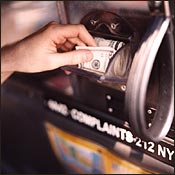
Taxis are different in New York. Since most of us don’t own cars, they’re our sole lifeline to the go-as-we-please mobility that’s taken for granted elsewhere in America. Round-the-clock designated drivers, they encourage all manner of late-night indulgence. And what other city can boast the gruff cabbie as a mascot? Forty thousand of these lone rangers travel more than a million miles a day (only 10 percent of which are racked up because they have no idea where they’re going). We even ride under the inalienable protection of a Taxicab Rider Bill of Rights.
But on May 3, our relationship with cabs will change. The base fare is going up to $2.50 from $2. Every tick of the meter (one-fifth of a mile) will cost 40 cents, up a dime. A trip to JFK from Manhattan will run $45, an increase of $10. One need not be able to graph the Keynesian theory of demand management on the back of a cocktail napkin to deduce that a 25 percent overall fare hike will wreak havoc on pocketbooks and, perhaps, knock our misty-eyed view of cabs askew.
When I can find one, a taxi is my preferred mode of travel. But under the new calculus of cab riding, it’s apparent that my freewheeling ways will dramatically affect my net worth. Based on my current average of six rides per week at $7 apiece, the increase will cost me at least $565 per year (that’s 283 subway or bus rides). Such a revelation is enough to make a man reconsider his spendthrift ways.
Adherence to a strict vow of cab celibacy, coupled with some disciplined investing, could produce a healthy windfall, according to a financial adviser I consulted (really). Over seven years, that modest $565, placed into the U.S. equity markets, could blossom into a robust $5,600, enough to think about buying a cab of my own. Over 25 years, the total yield could be nearly $60,000, a handy down payment on the matching taxi medallion.
There are, I suppose, ways to recoup a portion of this sum without giving up cabs completely. I could tap the pedicab market, but I prefer to reach my destination not smelling of bus fumes and in less time than it would take to use a Big Wheel.
Still, there are borderline situations where I will curtail my cab usage. Public transport will suffice for nonemergency doctor visits, for example. It will take two subway line changes, rather than just one, to make me opt for a cab. That ten-block round-trip to Circuit City for a new toner cartridge will become an opportunity to walk with the people. And my perfect punctuality record for dinners with married ex-girlfriends? It’s likely to slip.
Unfortunately, this reasoning also operates in reverse. The new JFK fare is nearly the same as what a private car service would cost. Suddenly, the comfort of a Lincoln Town Car is that much more tempting. And the mandate to make all cabs credit-card-ready by 2005, thus enabling deferred-payment joyrides, may swing the pendulum back to frivolity.
Of course, fiscal considerations of any kind are likely to recede the next time I step into a frigid rainstorm after a night of heavy drinking at the Corner Bistro. I’ll no doubt be offering a handsome profit to the first driver who doesn’t speed by with his OFF DUTY beacon lit.
And therein lies the cagey logic of the Taxi and Limousine Commission: The fare hikes are big enough to be frustrating but not to affect overall demand. We New Yorkers are too taxi-dependent to curb our collective addiction.
But still. The logic of fiscal restraint will slowly sink in. We’ll begin to think twice about sliding into cramped, faux-leather backseats—or at least watch the meter more attentively. And even if our habits don’t change, our unconditional devotion to cabs will be tempered. As the voice of Elmo used to tell us, buckle up. It’s going to be a bumpy ride.
NEW FARE STRUCTURE, MAY 3
Initial charge: $2.50
(was $2)
Mileage: 40 cents per 1/5 mile
(was 30 cents)
Waiting charge: 40 cents per 120 seconds
(was 30 cents per 90 seconds)
JFK flat fare: $45
(was $35)
Newark surcharge: $15
(was $10)
4 p.m.–8 p.m. weekday
Surcharge: $1
(new charge)
Pay By Credit
Will be added to all cabs by November 1, 2005.
GPS Systems
Used to collect cab-movement data and to power a Passenger Information Monitor screen that lets riders follow their trip in progress. Will be up by November 1, 2005.
Group-Ride Stands
The TLC will experiment with sites where riders can take cabs to common destinations.
WHERE THE MONEY GOES
Cab lease rates change daily. But based on maximum rates, drivers will make about $35 more per shift under the new fares. Owners will make about $8 more per cab per shift.
ROUND THE WORLD IN THE BACK SEAT
Complain about the new rates all you like. Have you taken a cab in Europe lately?
(Fares are based on the average cost of a sixty-block journey.)
New York: $10
London: $18
Paris: $12
Tokyo: $15
Rio de Janeiro: $3.50
Los Angeles: $9.50
Sydney: $11
DRIVER INCOME
Old Fare Average: $33,000
Old Fare High: $57,600
New Fare Average: $43,200
New Fare High: $74,880
TICKET TO RIDE
Trips per day: 470,000
Percentage of rides originating in Manhattan: 90
Times a Manhattanite hails a cab annually: 100